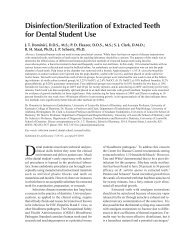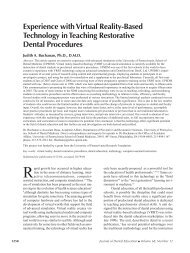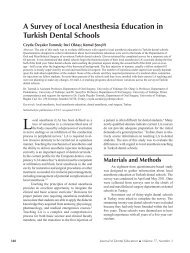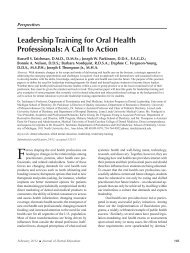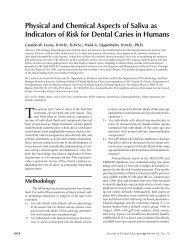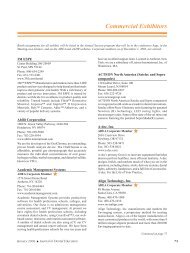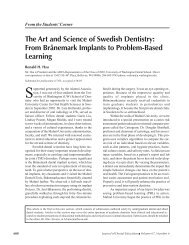Figure 3. Relationship of basic research in biomedical informatics to the spectrum of applications in biomedicineBasic ResearchMedical <strong>Informatics</strong> Methods,Techniques, and TheoriesApplied ResearchBioinformaticsImaging<strong>Informatics</strong>Clinical<strong>Informatics</strong>Public Health<strong>Informatics</strong>Molecular andCellularProcessesTissues andOrgansIndividuals(Patients)Populations<strong>An</strong>d SocietySource: Shortliffe E, Johnson S. Medical informatics training and research at Columbia University. Yearbook of Medical <strong>Informatics</strong>2002;173-80. Reprinted with permission from Schattauer Verlag, Stuttgart, Germany.claim informatics as part of their domain. On theother hand, an excessive number of boundaries hasthe danger of balkanizing biomedical informatics asa whole.It is obvious that the spectrum of research questionsranging from the cellular and molecular levelto public health is similar in most clinical disciplines.It is also intuitive that most informatics methods aremore or less broadly applicable across this range ofresearch questions. The differences seem to clusterin the applied domain, where discipline-specific solutionsare most needed. To give a practical example,much energy, thought, and effort have been expendedon the development of computer-based patientrecords. 40 Many innovations in computerizing medicalrecords, however, have had little or no utility fordentistry. For instance, representational schemes andstandards for clinical data, such as the SNOMED,the Reed Codes, the ICD, and HL-7, typically don’trepresent dental concepts and data very well. Sincethe representations are not the same, computer systemsfor inputting, storing, managing, and analyzinginformation must necessarily differ. Differencesat the systems level, such as the practice setting(which in dentistry is heavily weighted towards thesolo practitioner model), the distribution of generalistsand specialists, and reimbursement schemes, alsotend to limit the transferability of theories, methods,and applications from one setting to another.However, despite the fact that many practicalproblems require discipline-specific solutions, broadand interdisciplinary collaboration within the biomedicalinformatics community seems to be one ofthe best ways to develop these solutions. As inclusiveand broad communities of researchers, such asthe American Medical <strong>Informatics</strong> Association, continueto illustrate, enormous opportunities for crossfertilizationand collaboration across health disciplinesexist. This spirit is also embodied in thephilosophies of most biomedical informatics trainingprograms 22,41,42 that train physicians, dentists,nurses, pharmacologists, computer scientists, and individualsfrom many other disciplines with curriculathat share a common core, but are adapted to theneeds of specific disciplines.1198 Journal of <strong>Dental</strong> Education ■ Volume 67, Number 11
ConclusionThe purpose of informatics is to solve practicalproblems for researchers, practitioners, and educators.Before informatics can be helpful, however,its “customers” must understand exactly whatinformatics is and what it is not. Unfortunately, confusionabout the nature, differences, and commonalitiesof informatics and IT has resulted in manymisconceptions and false starts. To be truly useful,informatics must be understood as what it is: a researchdiscipline aimed at uncovering generalizableprinciples. With a better understanding of its goalsand methods, individuals in applied areas will be ableto identify more easily how informatics could potentiallyhelp them in their own work. Conversely,informaticians must learn as much as possible aboutthe research issues and problems in the applied areas,so they can target their work at the resolution ofreal, fundamental problems.AcknowledgmentsThe author thanks Pat <strong>An</strong>derson and HeikoSpallek, as well as the reviewers, for their helpfulcomments and <strong>An</strong>drea Hyde for her assistance inpreparing the bibliography.REFERENCES1. Collen MF. A history of medical informatics in the UnitedStates.Washington, DC: American Medical <strong>Informatics</strong>Association, 1995.2. Ledley RS, Lusted LB. Reasoning foundations of medicaldiagnosis. Science 1959;130:9-21.3. Perry CA. Knowledge bases in medicine: a review. BullMed Libr Assoc 1990;78(3):271-82.4. Zimmerman JL, Ball MJ, Petroski SP. Computers in dentistry.Dent Clin North Am. 1986;30(4):739-43.5. Schleyer T. How should dental informatics evolve? J DentEduc 1996;60(3):291-5.6. Schleyer T, Spallek H. <strong>Dental</strong> informatics: a cornerstoneof dental practice. J Am Dent Assoc 2001;132(5):605-13.7. University of Pittsburgh Center for <strong>Dental</strong> <strong>Informatics</strong>.<strong>Dental</strong> informatics postgraduate program. 2000. At:di.dental.pitt.edu/programs/pg/. Accessed: October 24,2003.8. Columbia University. Columbia University biomedicalinformatics. 2000. At: www.dmi.columbia.edu/. Accessed:October 24, 2003.9. Shahar Y. Medical informatics: between science and engineering,between academia and industry. Methods InfMed 2002;41(1):8-11.10. Musen MA. Medical informatics: searching for underlyingcomponents. Methods Inf Med 2002;41(1):12-9.11. Maojo V, Martin F, Crespo J, Billhardt H. Theory, abstractionand design in medical informatics. Methods InfMed 2002;41(1):44-50.12. Patel VL, Kaufman DR. Science and practice: a case formedical informatics as a local science of design. J AmMed Inform Assoc 1998;5(6):489-92.13. Friedman CP. Where’s the science in medical informatics?J Am Med Inform Assoc 1995;2(1):65-7.14. Montironi R, Whimster WF, Collan Y, Hamilton PW,Thompson D, Bartels PH. How to develop and use a Bayesianbelief network. J Clin Pathol 1996;49(3):194-201.15. Bates DW, Ebell M, Gotlieb E, Zapp J, Mullins HC. Aproposal for electronic medical records in U.S. primarycare. J Am Med Inform Assoc 2003;10(1):1-10.16. 2000 survey of current issues in dentistry: dentists’ computeruse. Chicago: American <strong>Dental</strong> Association, 2001.17. White SC. Decision-support systems in dentistry. J DentEduc 1996;60(1):47-63.18. Kaplan B, Flatley Brennan P, Dowling AF, Friedman CP,Peel V. Toward an informatics research agenda: key peopleand organizational issues. J Am Med Inform Assoc2001;8(3):235-41.19. Friedman CP, Wyatt JC. Evaluation methods in medicalinformatics. New York: Springer, 1996.20. Friedman CP, Elstein AS, Wolf FM, Murphy GC, FranzTM, Heckerling PS, et al. Enhancement of clinicians’ diagnosticreasoning by computer-based consultation: amultisite study of 2 systems. JAMA 1999;282(19):1851-6.21. Musen M, van Bemmel JH. Challenges for medicalinformatics as an academic discipline. Methods Inf Med2002;41:1-3.22. Shortliffe E, Johnson S. Medical informatics training andresearch at Columbia University. Yearbook of Medical<strong>Informatics</strong> 2002;173-80.23. Covvey HD, Zitner D, Bernstein R, MacNeill JE. Thedevelopment of model curricula for health informatics.Medinfo 2001;10(Part 2):1009-13.24. Frisse ME, Musen MA, Slack WV, Stead WW. Howshould we organize to do informatics? Report of the ACMIDebate at the 1997 AMIA Fall Symposium. J Am MedInform Assoc 1998;5(3):293-304.25. Bose H. Information science: principles and practice. NewDelhi: Sterling Publishers Private Ltd., 1993.26. Kochen M. Principles of information retrieval. Los <strong>An</strong>geles:Melville Publishing Co., 1974.27. Tufte ER. The visual display of quantitative information.16th ed. Cheshire, Conn.: Graphics Press, 1983.28. Tufte ER. Envisioning information. Cheshire, Conn.:Graphics Press, 1990.29. Tufte ER. Visual explanations: images and quantities,evidence and narrative. Cheshire, Conn.: Graphics Press,1997.30. Powsner SM, Tufte ER. Graphical summary of patientstatus. Lancet 1994;344(8919):386-9.31. Swanson DR, Smalheiser NR. <strong>An</strong> interactive system forfinding complementary literatures: a stimulus to scientificdiscovery. Artificial Intelligence 1997;97:183-203.32. Dale NB, Lewis J. Computer science illuminated. Boston:Jones & Bartlett Publishers, 2002.November 2003 ■ Journal of <strong>Dental</strong> Education 1199



